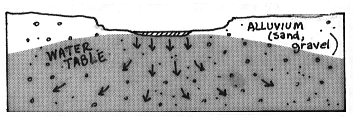 Albuquerque's Environmental Story
Albuquerque's Environmental Story
Educating For a Sustainable Community
Albuquerque's Natural Environment
Valley Sides and Terraces
- TERRAIN - Moderately to steeply sloping area grading from mesa to
floodplain or river. Upper boundary marked by sharp break in slope, local
relief of 50 feet (15 m.) plus, and slopes often 10%. Lower areas gentler,
smoother, except below terrace.
- CLIMATE AND AIR QUALITY - Description: warm, dry, semi-arid
climate like that of mesa units, except that extremes are somewhat greater.
Comments: susceptible to erosion from flash flooding and wind. Air
quality problems in urbanized areas.
- GEOLOGY - River-cut cliffs and valley sides in older river-laid
terraces. Cut and fill material is composed of reworked sands and gravel of
the Santa Fe Group. Resources and Hazards: principal resources consist
of extensive deposits of sand and gravel; common hazards such as flooding
in numerous arroyos.
- SOILS - Association: Bluepoint-Kokan, Madurez-Wink. Description:
Madurez-Wink soils on isolated river-cut terraces; see "Sand Plains"
for description and characteristics. Bluepoint-Kokan soils are excessively
drained loamy and/or gravelly sandy soils found as slopewash over terraces.
Notable Characteristics: locally severe water erosion, sedimentation,
sloughing, corrosivity and slope problems. Otherwise use potential is moderate
overall on slopes less than 15%.
- HYDROLOGY - Upper areas have closely spaced sub parallel gullies
which join to form arroyos; in lower areas the arroyos diffuse to broad, poorly
defined drainage ways or sheet flow areas, and can cause widespread shallow
flooding. Flows occur in response to summer storms, here or on mesa. Ground
water depth varies; aquifer is Santa Fe Group. Quality is generally good;
some municipal wells are in this unit.
- VEGETATION - Zone: Upper Sonora. Indicator Species: see "Sand
Plains" unit for terrace areas; snake weed, Russian thistle and other
species indicating disturbance inhabit valley sides, along with grasses. Productivity;
Sensitivity: only marginally productive except along water courses, which
are good wildlife habitats. Relatively insensitive to human activities because
already severely disturbed.
- WILDLIFE - Indicator Species: burrowing rodents, owls, or
other animals which "adopt" burrows in valley sides, including rattlesnakes
and many feral dogs from urban areas. Value: arroyo sides provide moist
inner-city habitats
for burrowing owls, ground squirrel, field mice. Generally, less rich fauna
than found in other units.

(Up to Section I, Back to
Sand Plains, On to River)
Copyright © 2008, Friends of Albuquerque's Environmental Story
